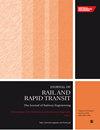Mechanism and improvement for tail vehicle swaying of power-centralized EMUs
IF 2.1
4区 工程技术
Q3 ENGINEERING, CIVIL
Proceedings of the Institution of Mechanical Engineers Part F-Journal of Rail and Rapid Transit
Pub Date : 2024-09-07
DOI:10.1177/09544097241278761
引用次数: 0
Abstract
The swing phenomenon of the tail vehicle will reduce the stability of the train operation, and even seriously deteriorate the ride comfort of passengers. In response to the relevant railway department, this paper reported the different dynamics performances in tail vehicle swaying when power-concentrated EMUs passed through a tunnel under push/pull operation. To analyze the characteristics and mechanism of the EMU tail swaying, field tests and numerical simulations were conducted. Firstly, through the on-track test, it was found that under push operation, the EMU tail continued to sway at a frequency of 1.3 Hz inside the tunnel, while under pull operation, only a swing of 1.7 Hz appeared at the tunnel entrance. Subsequently, through a simulation analysis, it was found that under push operation, the vortex-induced vibration of the tail carbody occurred inside the tunnel, leading to the sustained swing with a carbody hunting frequency of 1.3 Hz; under pull operation, due to the aerodynamic effect of the tunnel entrance, the secondary lateral stop had an abnormal elastic collision with the bogie frame, and the lateral impact on the bottom of the tail carbody caused a swing of 1.7 Hz, which was verified by the field test. Finally, for the motor vehicle of the EMU tail, two improvement measures of yaw damper optimization were proposed to alleviate the EMU tail swaying inside the tunnel. Furthermore, the research results can provide a reference for the aerodynamic swing problem of other trains, which has certain engineering significance.动力集中型动车组尾部车辆摇摆的机理与改进
尾部车辆的摆动现象会降低列车运行的稳定性,甚至严重影响乘客的乘坐舒适性。为响应铁路相关部门的要求,本文报道了动力集中型动车组在推/拉运行方式下通过隧道时尾部车辆摇摆的不同动力学表现。为了分析动车组尾部摇摆的特性和机理,本文进行了现场试验和数值模拟。首先,通过轨道测试发现,在推式操作下,动车组尾部在隧道内以 1.3 赫兹的频率持续摇摆,而在拉式操作下,仅在隧道入口处出现 1.7 赫兹的摇摆。随后,通过仿真分析发现,在推式运行时,尾部车体在隧道内发生涡流诱发振动,导致车体持续摆动,车体狩猎频率为 1.3 Hz;在拉式运行时,由于隧道口的空气动力效应,副侧挡与转向架构架发生异常弹性碰撞,尾部车体底部受到侧向冲击,导致车体摆动频率为 1.7 Hz,现场试验验证了这一结论。最后,针对动车组尾部的机动车辆,提出了偏航减振器优化的两种改进措施,以缓解动车组尾部在隧道内的摇摆。此外,研究成果还可为其他列车的气动摆动问题提供参考,具有一定的工程意义。
本文章由计算机程序翻译,如有差异,请以英文原文为准。
求助全文
约1分钟内获得全文
求助全文
来源期刊

CiteScore
4.80
自引率
10.00%
发文量
91
审稿时长
7 months
期刊介绍:
The Journal of Rail and Rapid Transit is devoted to engineering in its widest interpretation applicable to rail and rapid transit. The Journal aims to promote sharing of technical knowledge, ideas and experience between engineers and researchers working in the railway field.
 求助内容:
求助内容: 应助结果提醒方式:
应助结果提醒方式:


